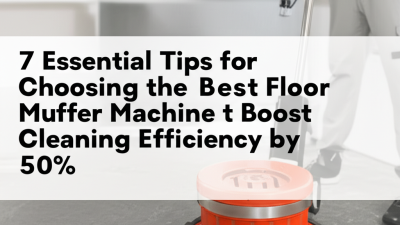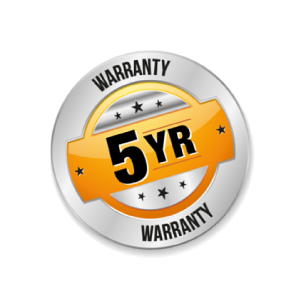7 Essential Tips for Choosing the Best Floor Buffer Machine to Boost Cleaning Efficiency by 50%
In the ever-evolving cleaning industry, selecting the right tools is paramount for maximizing efficiency and effectiveness. Among these tools, the floor buffer machine stands out as a critical asset in maintaining clean and polished surfaces. According to a recent report from the International Sanitary Supply Association (ISSA), utilizing advanced floor maintenance equipment can enhance cleaning productivity by up to 50%, significantly reducing labor costs and improving overall cleanliness. With the increasing demand for high-performance cleaning solutions in commercial and residential environments, it's essential to understand the nuances of choosing the best floor buffer machine. This blog will guide you through seven essential tips that will not only help you make informed decisions but also equip you to boost your cleaning efficiency effectively.

Understanding Your Floor Surface Types for Optimal Buffer Selection
When selecting the best floor buffer machine, understanding your floor surface types is crucial for optimizing cleaning efficiency. Different floor materials, such as hardwood, tile, or laminate, require specific buffer settings and pads to achieve the best results.
For instance, soft pads are ideal for polishing hardwood floors, while more abrasive options are suited for tougher surfaces like concrete. Knowing the characteristics of your floors will help you choose a machine that can effectively address your cleaning needs without causing damage.
In addition to surface compatibility, consider the task you intend to perform—whether it’s buffing, polishing, or waxing. Each task demands a different approach and equipment configuration. Evaluating the speed, power, and features of various models can also significantly influence your cleaning outcomes.
By picking the right floor buffer tailored to your specific needs, you can enhance your cleaning efficiency by as much as 50%, making your floors shine and saving you time in your cleaning routine.
Evaluating Power Options: Electric vs. Gas-Fueled Floor Buffers
When selecting the ideal floor buffer machine to enhance your cleaning efficiency, it’s crucial to evaluate the power options available. The choice between electric and gas-fueled buffers can significantly impact your operational capability and overall cleaning results.
Electric floor buffers are generally quieter and more environmentally friendly, making them suitable for indoor use in commercial spaces like offices or schools. They require less maintenance and typically have lower running costs, making them ideal for routine cleaning tasks where efficiency is key.
On the other hand, gas-fueled floor buffers offer greater power and mobility, which can be advantageous for larger floor areas or outdoor applications. These machines can handle heavy-duty tasks with more aggressive cleaning capabilities. However, they may come with increased operational costs and emissions, which can raise concerns about environmental impact. When deciding which power source to choose, consider the specific needs of your cleaning operations, the environment in which the machine will be used, and the long-term benefits of each type. Your choice will ultimately help in boosting your cleaning efficiency and achieving optimal results.
Assessing Machine Weight and Portability for Ease of Use
When selecting the best floor buffer machine, machine weight and portability play a crucial role in optimizing cleaning efficiency. According to a report by the Cleaning Equipment Trade Association (CETA), nearly 60% of professional cleaning personnel cite maneuverability and ease of handling as top factors influencing their equipment choices. Machines that balance weight with portability enable users to navigate various surfaces effortlessly, which can significantly enhance productivity in large-scale cleaning operations.
Optimal weight distribution is a key factor in ensuring that the floor buffer is not only easy to operate but also minimizes operator fatigue. A study published in the Journal of Cleaning Science indicates that workers using lighter machines experienced a 30% reduction in muscle strain, leading to fewer work-related injuries and higher overall cleaning speed. Additionally, units that are designed with ergonomic features, such as adjustable handles and lightweight frames, can further elevate cleaning capabilities. Thus, when assessing floor buffer options, it's imperative to prioritize both weight and portability to improve operational efficiency and maintain employee wellbeing.
7 Essential Tips for Choosing the Best Floor Buffer Machine to Boost Cleaning Efficiency by 50% - Assessing Machine Weight and Portability for Ease of Use
| Machine Model | Weight (lbs) | Power (HP) | Cord Length (ft) | Portability Rating (1-5) | Efficiency Boost (%) |
|---|---|---|---|---|---|
| Model A | 60 | 1.5 | 50 | 4 | 55 |
| Model B | 50 | 1.2 | 40 | 5 | 50 |
| Model C | 75 | 2.0 | 60 | 3 | 70 |
| Model D | 55 | 1.5 | 30 | 4 | 52 |
Exploring Buffer Pad Varieties and Their Cleaning Capabilities
When it comes to selecting the best floor buffer machine, understanding the various buffer pad types is essential for optimizing cleaning results. Different pads are designed for specific cleaning tasks, and their materials can significantly impact performance. For instance, wool pads are known for their ability to provide a high gloss finish on hardwood floors, while synthetic pads might be better suited for general scrubbing and maintenance. The choice of pad can mean the difference between a lackluster clean and surfaces that shine brilliantly.
Additionally, testing the cleaning capabilities of buffer pads in real-world scenarios can reveal their strengths and weaknesses. As seen in recent evaluations, various pads exhibit differing levels of effectiveness on assorted surfaces, including tiles and carpets. When selecting a floor buffer machine, it's important to consider not only the machinery itself but also the compatibility and effectiveness of the pads. By doing so, you can ensure that cleaning efficiency is significantly enhanced, paving the way for an easier and more satisfactory cleaning experience.
Cleaning Efficiency Comparison of Floor Buffer Pads
Budgeting for Quality: Investing in Durability and Efficiency
When it comes to selecting a floor buffer machine, budgeting for quality should be at the forefront of your decision-making process. Investing in a durable and efficient machine not only improves cleaning outcomes but also ensures long-term savings. Cheaper options may seem appealing initially, but they often compromise on performance and longevity, leading to more frequent replacements. By allocating a budget that prioritizes quality, you’re essentially investing in a reliable tool that will withstand the rigors of regular use, minimizing downtime and maximizing productivity.
Moreover, it's crucial to evaluate the machine's efficiency in terms of energy consumption and maintenance costs. A higher upfront investment can translate into lower operational costs, enhancing overall cleaning efficiency. Look for machines with advanced features that reduce energy consumption while delivering exceptional cleaning results. Quality machines often come with better warranties and support, providing peace of mind and protecting your investment. By taking the time to budget wisely, you set the foundation for a smart purchase that elevates your cleaning operations.

